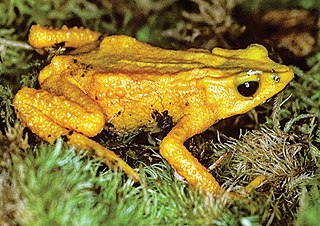
Atelopus longirostris is a species of harlequin frog, a member of the family of true toads (Bufonidae). It has been recorded only in northern Ecuador. Records from Colombia probably represent different species. As of mid-2017, it is listed as extinct by the IUCN, but was rediscovered in 2016 after more than two decade with no sightings, likely because the IUCN last assessed it in 2004. The scientific name of this species means "long-snout" and the species has been named in Spanish as the jambato hocicudo. Common names longnose stubfoot toad, scrawny stubfoot-toad, and longnose sharlequin frog have been coined for it.
Atelopus angelito, the Angelito stubfoot toad, is a species of toads in the family Bufonidae endemic to Colombia. Its natural habitats are subtropical or tropical moist montane forests, subtropical or tropical high-altitude shrubland, and rivers.
The Rio Carauta stubfoot toad is a species of toad in the family Bufonidae endemic to Colombia; this anuran is found only within the Northwestern Andean montane forests. Its natural habitats are subtropical or tropical moist montane forests and rivers. The species is threatened by habitat loss.

Atelopus carbonerensis, also known as the Venezuelan yellow frog and La Carbonera stubfoot toad, is a species of toad in the family Bufonidae. It is endemic to the Mérida Andes of Venezuela. Following an observation in 1998, it was feared extinct for nearly two decades until a single individual was sighted in 2014, followed by an observation of a mating pair in 2021.

Atelopus certus, the Darien stubfoot toad or Toad Mountain harlequin frog, is a species of toad in the family Bufonidae endemic to Panama.

Atelopus chiriquiensis, the Chiriqui harlequin frog or Lewis' stubfoot toad, is an extinct species of toad in the family Bufonidae that was found in the Cordillera de Talamanca in Costa Rica and western Panama. Its natural habitats were stream margins in lower montane wet forests and rainforests. Its elevational range was 1,400–2,500 m (4,600–8,200 ft) asl.

The elegant stubfoot toad or Pacific jambato frog is a species of toad in the family Bufonidae found in lowlands and Andean slopes of northwest Ecuador to 1,140 m (3,740 ft) asl and on the Gorgona Island, off southwest coast of Colombia. It was described by George Albert Boulenger in 1882 based on a specimen collected by Edward Whymper. It is known in Spanish as rana jambato del Pacífico or simply jambato del Pacífico.
Atelopus farci, the forest stubfoot toad, is a species of toad in the family Bufonidae. It is endemic to Colombia and only known from its type locality, Granjas del Padre Luna, in Albán, Cundinamarca, on the western flank of the Cordillera Oriental at about 2,100 m (6,900 ft) above sea level. Its natural habitat is cloud forest where it lives in streams.

Atelopus glyphus, the Pirri harlequin frog or Pirri Range stubfoot toad, is a species of toad in the family Bufonidae found in Colombia and Panama within the Northwestern Andean montane forests. Its natural habitats are subtropical or tropical moist montane forests and rivers.

Atelopus limosus, the limosa harlequin frog is an endangered species of toad in the family Bufonidae endemic to Panama. Its natural habitats are stream banks in tropical moist lowland forests and rivers of the Chagres watershed in central Panama.
The Mindo stubfoot toad or Mindo harlequin-toad is a species of toad in the family Bufonidae. It is endemic to Ecuador in Pichincha, Santo Domingo and Cotopaxi Provinces. Its natural habitats are subtropical or tropical moist lowland forests, subtropical or tropical moist montane forests, and rivers. It has a unique appearance and color pattern, being green and red with white speckles, and due to this it was once considered an emblematic species of the Mindo Valley.
Atelopus minutulus is a species of toad in the family Bufonidae. It is endemic to Colombia. Its natural habitats are subtropical or tropical moist montane forests and rivers. It is threatened by habitat loss.
Atelopus petriruizi, more commonly known as the painted stubfoot toad, is a species of toad in the family Bufonidae. Endemic to Colombia, the toad's natural habitats are subtropical or tropical moist montane forests and rivers. Threatened by habitat loss, the Ateopus petriruizi is currently classified as critically endangered, and was placed on the IUCN red list in 2017. Currently, there may be less than 49 remaining mature A. Petriruizi.
The green and red venter harlequin toad is a species of toad in the family Bufonidae. It is endemic to Venezuela. Its natural habitats are subtropical or tropical moist montane forests, rivers, and intermittent rivers. It is threatened by habitat loss.
Atelopus sonsonensis is a species of toad in the family Bufonidae. It is endemic to Colombia and only known from its type locality in Sonsón, Antioquia Department, on the eastern slope of the Cordillera Central at 1,500 m (4,900 ft) asl.
The scarlet harlequin toad or sapito arlequin de Soriano is a species of toad in the family Bufonidae. It is endemic to Venezuela. Its natural habitats are subtropical or tropical moist montane forests and rivers. The scarlet harlequin toad was a bright orange, with males growing up to 38-41.5mm and females growing up 42-50mm. It is threatened by habitat loss, and may already be extinct. The toad is among the 25 “most wanted lost” species that are the focus of Re:wild’s “Search for Lost Species” initiative.
The Tamá harlequin frog or Venezuela stubfoot toad is a species of toad in the family Bufonidae. It is endemic to the Páramo de Tamá on the Venezuelan-Colombian border and occurs in Apure and (likely) Táchira states of Venezuela and Norte de Santander Department on the Cordillera Oriental of Colombia.
Gastrophryne pictiventris is a species of frog in the family Microhylidae. It is found in northeastern Costa Rica and southeastern Nicaragua. This species is found in leaf-litter of lowland moist and wet forests. However, it is not easily seen outside the explosive breeding events. Breeding takes place in temporary pools.







